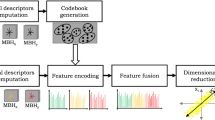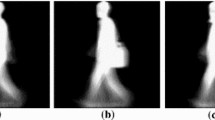Abstract
Human gait recognition is a biometric technique for persons identification based on their walking manner. This paper proposes a novel gait recognition approach capable of selecting information characteristics for human identification under different conditions including normal walking, carrying a bag and wearing a clothing for different angles of view; thereby enhancing the recognition accomplishment. The proposed approach relies on two feature extraction methods based on multi-scale feature descriptors including Multi-scale Local Binary Pattern (MLBP) and Gabor filter bank, through Spectra Regression Kernel Discriminant Analysis (SRKDA) reduction algorithm. The proposed features are extracted locally from two Region of Interest (ROIs) representing the dynamic areas in the Gait Energy Image (GEI). The experiments conducted on CASIA and USF Gait databases have shown that the suggested methods achieve better recognition performances up to 92% in terms of identification rate at rank-1 than the existing similar and recent state-of-the-art methods.





Similar content being viewed by others
References
Ahonen T, Hadid A, Pietikainen M (2009) Facial expression recognition based on local binary patterns: A comprehensive study. Image Vis Comput 27:803–816
Bashir K, Xiang T, Gong S (2009) Gait representation using flow fields. British Machine Vision Association (BMVC)
Bashir K, Xiang T, Gong S (2010) Gait recognition without subject cooperation. Pattern Recogn Lett 31(13):2052–2060
Baudat G, Anouar F (2000) Generalized discriminant analysis using a kernel approach. Neural Comput 12:2385–2404
Ben Abdelkader C, Cutler R, Davis L (2002) Stride and cadence as a biometric in automatic person identification and verification. In: 5th IEEE International Conference on Automatic Face and Gesture Recognition, pp 372–377
Boulgouris NV, Chi ZX (2007) Gait recognition using radon transform and linear discriminant analysis. IEEE Trans Image Process 16(2):731–740
Boulgouris NV, Hatzinakos D, Plataniotis KN (2005) Gait recognition: a challenging signal processing technology for biometric identification. IEEE Signal Process Mag 22(6):78–90
Bounneche MD, Boubchir L, Bouridane A, Nekhoul B, Ali-Chérif A (2016) Multi-spectral palmprint recognition based on oriented multiscale log-Gabor filters. Neurocomputing 205:274–286
Cai D, He X, Han J (2007) Efficient kernel discriminant analysis via spectral regression. In: 7th IEEE International Conference on Data Mining (ICDM), pp 427–432
Cai D, He X, Han J (2011) Speed up kernel discriminant analysis. The Int J Very Large Data Bases 20(1):21–33
CASIA Gait database. http://www.cbsr.ia.ac.cn
Dupuis Y, Savatier X, Vasseur P (2013) Feature subset selection applied to model-free gait recognition. Image Vis Comput 31(8):580–591
Guan Y, Li C-T, Roli F (2015) On reducing the effect of covariate factors in gait recognition: a classifier ensemble method. IEEE Trans Pattern Anal Mach Intell 37(7):1521–1528
Han J, Bhanu B (2006) Individual recognition using gait energy image. IEEE Trans Pattern Anal Mach Intell 28(2):316–322
Hu M, Wang Y, Zhang Z, Zhang D, Little JJ (2013) Incremental learning for video-based gait recognition with LBP fow. IEEE Trans Cybern 43(1):77–89
Isaac ERHP, Elias S, Rajagopalan S, Easwarakumar KS (2017) View-invariant gait recognition through genetic template segmentation. IEEE Signal Process Lett 24 (8):1188–1192
Jain AK, Flynn P, Ross AA (2007) Handbook of biometrics. Springer Ed., Berlin
Kusakunniran W, Wu Q, Li H, Zhang J (2009) Multiple views gait recognition using view transformation model based on optimized gait energy image. In: The 12th IEEE international conference on computer vision, pp 1058–1064
Kusakunniran W, Wu Q, Zhang J, Li H (2010) Support vector regression for multi-view gait recognition based on local motion feature selection. In: IEEE conference on computer vision and pattern recognition, pp 974–981
Lades M, Vorbruggen J, Buhmann J, Lange J, Von Der Malsburg C, Wurtz R, Konen W (1993) Distortion invariant object recognition in the dynamic link architecture. IEEE Trans Comput 42(3): 300–311
Lancieri L, Boubchir L (2007) Using multiple uncertain examples and adaptative fuzzy reasoning to optimize image characterization. Knowl-Based Syst 20(3):266–276
Lishani AO, Boubchir L, Bouridane A (2014) Haralick features for gei-based, human gait recognition. In: The 26th international conference on microelectronics (ICM), pp 36–39
Lishani AO, Boubchir L, Khalifa E, Bouridane A (2016) Gabor filter bank-based gei features for human gait recognition. In: The 39th international conference on telecommunications and signal processing (TSP), pp 648–651
Lishani AO, Boubchir L, Khalifa E, Bouridane A (2017) Gait recognition based on wavelet features with spectral regression kernel discriminant analysis. In: The 40th international conference on telecommunications and signal processing (TSP), pp 789–792
Lishani AO, Boubchir L, Khalifa E, Bouridane A (2017) Human gait recognition based on Haralick features. Signal Image Vid Process 11(6):1123–1130
Little J, Boyd JE (1995) Describing motion for recognition. International Symposium on Computer Vision
Little J, Boyd JE (1998) Recognizing people by their Gait: the shape of motion. Videre: J Comput Vis Res 1(2):1–32
Liu C, Wechsler H (2002) Gabor feature based classification using the enhanced fisher linear discriminant model for face recognition. IEEE Trans Image Process 11 (4):467–476
Lu H, Venetsanopoulos P (2006) A layered deformable model for gait analysis, pp 249–254
Mika S, Ratsch G, Weston J, Scholkopf B, Muller K (1999) Fisher discriminant analysis with kernels. In: IEEE neural networks for signal processing workshop, pp 41–48
Mohan Kumar HP, Nagendraswamy HS (2014) LBP for gait recognition: a symbolic approach based on GEI plus RBL of GEI. In: International conference on electronics and communication systems (ICECS), pp 1–5
Ng H, Tong H-L, Tan W-H, Yap TT, Chong P, Abdullah J (2011) Human identification based on extracted gait features. Int J New Comput Architectures Appl 1(2):358–370
Niyogi S, Adelson E (1994) Analyzing and recognizing walking figures in XYT. In: IEEE conference on computer vision and pattern recognition, pp 469–474
Ojala T, Pietikainen M, Harwood D (1996) A comparative study of texture measures with classification based on feature distributions. Pattern Recogn Lett 29 (1):1299–1319
Pietikainen M, Hadid A, Zhao G, Ahonen T (2011) Computer vision using local hinary patterns. Springer-Verlag, London
Sarkar S, Phillips PJ, Liu Z, Vega IR, Grother P, Bowyer KW (2005) The HumanID Gait challenge problem: data sets, performance, and analysis. IEEE Trans Pattern Anal Mach Intell 27(2): 162–177
Shan C, Gong S, McOwan P (2006) Face description with local binary patterns: application to face recognition. IEEE Trans Pattern Anal Mach Intell 28(12):2037–2041
Tao D, Li X, Wu X, Maybank SJ (2007) General tensor discriminant analysis and gabor features for gait recognition. IEEE Trans Pattern Anal Mach Intell 29(10):1700–1715
USF Human ID Gait database. http://figment.csee.usf.edu/GaitBaseline/
Wang L, Tan T, Ning H, Hu W (2003) Silhouette analysis-based gait recognition for human identification. IEEE Trans Pattern Anal Mach Intell 25 (12):1505–1518
Whytock T, Belyaev A, Robertson N (2014) Dynamic distance-based shape features for Gait recognition. J Math Imaging Vision 50(3):314–326
Yam C, Nixon M, Carter J (2004) Automated person recognition by walking and running via model-based approaches. Pattern Recogn 37(5):1057–1072
Yu S, Tan D, Tan T (2006) Modelling the effect of view angle variation on appearance-based Gait recognition. In: Asian conference on computer vision. Springer-Verlag Berlin Heidelberg, pp 708–816
Zhang H, Liu Z (2009) Gait representation and recognition using haar wavelet and radon transform. In: Proc WASE international conference on information engineering, pp 83–86
Author information
Authors and Affiliations
Corresponding author
Rights and permissions
About this article
Cite this article
Lishani, A.O., Boubchir, L., Khalifa, E. et al. Human gait recognition using GEI-based local multi-scale feature descriptors. Multimed Tools Appl 78, 5715–5730 (2019). https://doi.org/10.1007/s11042-018-5752-8
Received:
Revised:
Accepted:
Published:
Issue Date:
DOI: https://doi.org/10.1007/s11042-018-5752-8




